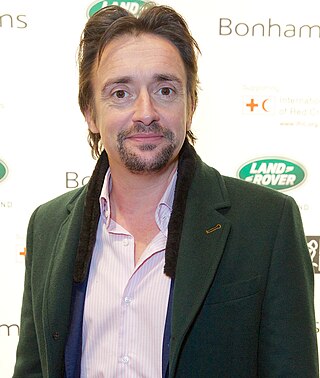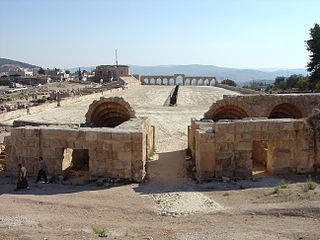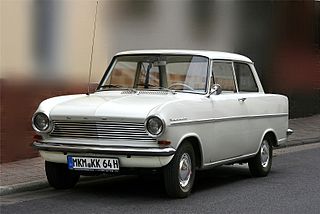
Richard Mark Hammond is an English journalist, television presenter, mechanic, and writer. He is best known for co-hosting the BBC Two motoring programme Top Gear from 2002 until 2015 with Jeremy Clarkson and James May. From 2016 to 2024, the trio presented Amazon Prime Video's The Grand Tour.

Maun is the fifth-largest town in Botswana. As of 2011, it had a population of 55,784. Maun is the "tourism capital" of Botswana and the administrative centre of Ngamiland district. Francistown and Maun are linked by the A3 highway. Maun is also the headquarters of numerous safari and air-charter operations who run trips into the Okavango Delta.

The Makgadikgadi Pan, a salt pan situated in the middle of the dry savanna of north-eastern Botswana, is one of the largest salt flats in the world. The pan is all that remains of the formerly enormous Lake Makgadikgadi, which once covered an area larger than Switzerland, but dried up tens of thousands of years ago. Recent studies of human mitochondrial DNA suggest that modern Homo sapiens first began to evolve in this region some 200,000 years ago, when it was a vast, exceptionally fertile area of lakes, rivers, marshes, woodlands and grasslands especially favorable for habitation by evolving hominins and other mammals.

Maun Airport is an international airport serving the town of Maun in the North-West District of Botswana. It is on the north side of the town and is accessible by shuttle bus or taxi.

Series 10 of Top Gear, a British motoring magazine and factual television programme, was broadcast in the United Kingdom on BBC Two during 2007, consisting of ten episodes that were aired between 7 October and 23 December. This series saw the props used on the programme being changed from car-based seating and a wide-screen monitor in the main set space, to wingback chairs and an old TV screen; although attributed to a fire caused by Top Gear's rival programme, it later was exposed as a publicity stunt, with the props replaced the following series. This series' highlights included the presenters crossing Botswana on a road trip, a race between a car and a fighter jet, fording amphibious cars across the English Channel, and competing in a 24-hour endurance race using home-made bio-diesel.
Top Gear challenges is a segment of the Top Gear television programme where the presenters are tasked by the producers, or each other, to prove or accomplish various tasks related to vehicles.
In Top Gear, a BBC motoring show, one of the show's regular features since 2002 is various forms of racing the presenters undertake, either against each other or against invited guests. The show has featured a number of epic races, where one of the presenters — Jeremy Clarkson, Richard Hammond, James May, and occasionally The Stig — drives a car in a race against the others in another form of transport. These races typically involve Clarkson driving the car while Hammond and May take the same journey by combinations of plane, train, or ferry. May has said that the races are planned to be as close as possible. Of the long-distance races so far, the car has won the vast majority of the races, with the exceptions of the cross-London epic, in which the car was beaten by a bicycle, a boat on the Thames and public transport; Ferrari Daytona vs. Powerboat, in which the boat won; Shelby Mustang GT500 vs. High Speed Train, in which the train won; and the Arabian Peninsula race, in which the alternative 'money no-object' transportation options beat the Bugatti Chiron.

Top Gear: Winter Olympics is a full-length, special edition episode for BBC motoring programme Top Gear, and is the first in a series of full-length specials for the show. The episode was aired on 12 February 2006, with a repeat of the episode being aired a week later on 19 February. The special saw hosts Jeremy Clarkson, Richard Hammond and James May travelling to Lillehammer, Norway and creating their own version of the Winter Olympics with cars. The episode was later released on DVD on 5 June later that year.
The British motoring-themed television programme Top Gear was often the focus of criticism. The criticism has ranged from minor viewer complaints to serious complaints where broadcasting watchdogs such as Ofcom have been involved.
Top Gear: Vietnam Special is a special 75-minute episode for BBC motoring programme Top Gear, and was first broadcast on 28 December 2008, as part of the final episode for the twelfth series, with the special repeated for UK TV channel Dave, initially in an edited, 46 minute version on 19 January 2009, but later revised to a 90-minute format following complaints by viewers. The special sees hosts, Jeremy Clarkson, Richard Hammond and James May, travelling 1,000 miles (1,600 km) across Vietnam with motorbikes, beginning from Ho Chi Minh City (Saigon), travelling north towards Hạ Long city, and finishing at a floating bar within Hạ Long Bay, a journey that had to be completed within eight days.

Top Gear: US Special is a full-length, special edition episode for BBC motoring programme Top Gear, and was first broadcast on BBC Two on 11 February 2007, as part of the 3rd episode of Series 9, with the special repeated in an edited version for UKTV channel Dave. The special sees hosts, Jeremy Clarkson, Richard Hammond, and James May travelling on a journey from Miami to New Orleans in three used cars to find if it's more economical to buy a vehicle rather than rent one. The Production Notes section of the Top Gear website describes the creation and production of this episode as "...damn near finishing off several members of the crew through exhaustion."
Top Gear Australia: Ashes Special is a special episode of the motoring series Top Gear Australia and Top Gear. It is part of the Channel Nine revamp of Top Gear Australia, which sees Australian hosts Ewen Page, Steve Pizzati and Shane Jacobson, take on the hosts of Top Gear, James May, Richard Hammond, and Jeremy Clarkson in a series of challenges involving the best and worst of British motoring, as well as a rally, and driving through a safari park. Other challenges include a drag race between a Holden VE Commodore ute and a standard looking Ford Transit van customised with a Jaguar XJ220 engine, and the double car race seen in Series 11 of Top Gear UK. An edited version of the Ashes Special was shown in the UK on 30 January 2011 as part of Series 16, Episode 2 of Top Gear UK.

"Top Gear: Middle East Special" is a 76-minute-long extended episode of Top Gear series 16. The film predates the Syrian Civil War and involves a 1,200-mile (1,900 km) road-trip from Erbil International Airport in Iraqi Kurdistan to Bethlehem, nominally recreating the journey of the Three Wise Men. Their journey takes them across the Middle East via southern Turkey, the cities of Aleppo, Palmyra and Damascus in Syria, then Jerash in Jordan and finally the Mount of Olives. The journey includes visiting an abandoned theme park, and a stop at Ein Gev on the Sea of Galilee.

The Opel Kadett was reintroduced by Opel in 1962, with deliveries beginning on 2 October, a little more than 22 years after the original model was discontinued in May 1940. Like the original Kadett, the new car was a small family car, although it was now available in 2-door saloon, 3-door Car-A-Van (estate) and coupé versions.

Series 22 of Top Gear, a British motoring magazine and factual television programme, was broadcast in the United Kingdom on BBC Two during 2015, consisting of eight episodes - seven of these were aired between 25 January and 8 March, while the eighth was aired on 28 June following a disruption in production; two additional episodes were planned but never produced. The series was preceded by a two-part special focused on the presenters conducting a road trip across Argentina, titled Top Gear: Patagonia Special, and aired during 2014 on 27–28 December. This series' highlights included the presenters conducting a race across St. Petersburg, creating home-made ambulances, a recreation of a famous Land Rover Defender advert, and a road trip across Australia in GT cars.

Top Gear: Patagonia Special is a full length special that was aired as a two-part episode for the BBC car show Top Gear; the first part was aired on 27 December 2014, while the second part was aired a day later on 28 December. The special sees hosts, Jeremy Clarkson, Richard Hammond, and James May, using a selection of cars with V8 engines to celebrate the 60th anniversary of the small-block V8 engine, on a journey across Chile and Argentina, starting from Bariloche and ending on the outskirts of Ushuaia, and includes the infamous scene involving the protesters that the presenters and their film crew encountered and the events that happened; it is the last Top Gear special to be filmed with the hosts, prior to Clarkson's exit from the show in March 2015 followed by Hammond, May, and Executive Producer Andy Wilman shortly afterwards. The incident with the protesters was widely documented and reported by the media, prior to the broadcast of the special.
Top Gear is a British motoring magazine and entertainment television programme. It is a revival by Jeremy Clarkson and Andy Wilman of the 1977–2001 show of the same name for the BBC, and premiered on 20 October 2002. The programme focuses on the examination and reviewing of motor vehicles, primarily cars, though this was expanded upon after the broadcast of its earlier series to incorporate films featuring motoring-based challenges, special races, timed laps of notable cars, and celebrity timed laps on a course specially-designed for the relaunched programme. The programme drew acclaim for its visual and presentation style since its launch, which focused on being generally entertaining to viewers, as well as criticism over the controversial nature of its content. The show was also praised for its occasionally-controversial humour and lore existing in not just the automotive community but in the form of internet memes and jokes. The programme was aired on BBC Two until it was moved to BBC One for its twenty-ninth series in 2020.
The Grand Tour is a British motoring television series, created by Jeremy Clarkson, Richard Hammond, James May and Andy Wilman, made for Amazon exclusively for its online streaming service Amazon Prime Video, and premiered on 18 November 2016. The programme was conceived in the wake of the departure of Clarkson, Hammond, May and Wilman from the BBC series Top Gear and was originally contracted with 36 episodes over three years.

"The Holy Trinity" is the first episode of British motoring series The Grand Tour. It was made available exclusively through the Amazon Video streaming service, first on 17 November 2016 at 23:00 GMT. Jeremy Clarkson, Richard Hammond, and James May, who previously presented as a trio on BBC Two motoring programme Top Gear, present the show. Production of the episode was handled by W. Chump and Sons, with executive production done by Andy Wilman, who previously served as the executive producer of Top Gear.
Series 28 of Top Gear, a British motoring magazine and factual television programme, was broadcast in the United Kingdom on BBC Two during 2020, consisting of six episodes between 26 January and 1 March; the series' studio segments were filmed prior to the outbreak of the COVID-19 pandemic in the UK. The series was preceded by a feature-length special, involving a road trip by the presenters across Nepal, that was aired on 29 December 2019.













